�
OXFORD MASTER SERIES IN PHYSICS
OXFORD MASTER SERIES IN PHYSICS
The Oxford Master Series is designed for final year undergraduate and beginning graduate students in physics
and related disciplines. It has been driven by a perceived gap in the literature today. While basic undergraduate
physics texts often show little or no connection with the huge explosion of research over the last two decades,
more advanced and specialized texts tend to be rather daunting for students. In this series, all topics and their
consequences are treated at a simple level, while pointers to recent developments are provided at various stages.
The emphasis is on clear physical principles like symmetry, quantum mechanics, and electromagnetism which
underlie the whole of physics. At the same time, the subjects are related to real measurements and to the
experimental techniques and devices currently used by physicists in academe and industry. Books in this series
are written as course books, and include ample tutorial material, examples, illustrations, revision points, and
problem sets. They can likewise be used as preparation for students starting a doctorate in physics and related
fields, or for recent graduates starting research in one of these fields in industry.
CONDENSED MATTER PHYSICS
1. M. T. Dove: Structure and dynamics: an atomic view of materials
2. J. Singleton: Baud theory and electronic properties of solids
3. A. M. Fox: Optical properties of solids
4. S. J. Blundell: Magnetism in condensed matter
5. J. F. Annett: Superconductivity
6. R. A. L. Jones: Soft condensed matter
ATOMIC, OPTICAL, AND LASER PHYSICS
7. C. J. Foot: Atomic Physics
8. G. A. Brooker: Modern classical optics
9. S. M. Hooker, C. E. Webb: Laser physics
15. A. M. Fox: Quantum optics: an introduction
PARTICLE PHYSICS, ASTROPHYSICS, AND COSMOLOGY
10. D. H. Perkins: Particle astrophysics
11. Ta-Pei Cheng: Relativity, gravitation, and cosmology
STATISTICAL, COMPUTATIONAL, AND THEORETICAL PHYSICS
12. M. Maggiore: A modern introduction to quantum field theory
13. W. Krauth: Statistical mechanics: algorithms and computations
14. J. P. Sethna: Entropy, order parameters, and complexity
�
Quantum Optics
An Introduction
MARK FOX
Department of Physics and Astronomy
University of Sheffield
1
�
3
Great Clarendon Street, Oxford OX2 6DP
Oxford University Press is a department of the University of Oxford.
It furthers the University’s objective of excellence in research, scholarship,
and education by publishing worldwide in
Oxford New York
Auckland Cape Town Dar es Salaam Hong Kong Karachi
Kuala Lumpur Madrid Melbourne Mexico City Nairobi
New Delhi Shanghai Taipei Toronto
With offices in
Argentina Austria Brazil Chile Czech Republic France Greece
Guatemala Hungary Italy Japan Poland Portugal Singapore
South Korea Switzerland Thailand Turkey Ukraine Vietnam
Oxford is a registered trade mark of Oxford University Press
in the UK and in certain other countries
Published in the United States
by Oxford University Press Inc., New York
c Oxford University Press 2006
The moral rights of the author have been asserted
Database right Oxford University Press (maker)
First published 2006
All rights reserved. No part of this publication may be reproduced,
stored in a retrieval system, or transmitted, in any form or by any means,
without the prior permission in writing of Oxford University Press,
or as expressly permitted by law, or under terms agreed with the appropriate
reprographics rights organization. Enquiries concerning reproduction
outside the scope of the above should be sent to the Rights Department,
Oxford University Press, at the address above
You must not circulate this book in any other binding or cover
and you must impose the same condition on any acquirer
British Library Cataloguing in Publication Data
Data available
Library of Congress Cataloging in Publication Data
Fox, Mark (Anthony Mark)
Quantum optics : an introduction/Mark Fox.
p. cm. — (Oxford master series in physics ; 6)
Includes bibliographical references and index.
ISBN-13: 978–0–19–856672–4 (hbk. : acid-free paper)
ISBN-10: 0–19–856672–7 (hbk. : acid-free paper)
ISBN-13: 978–0–19–856673–1 (pbk. : acid-free paper)
ISBN-10: 0–19–856673–5 (pbk. : acid-free paper)
1. Quantum optics.
QC446.2.F69 2006
535.15—dc22
II. Series.
I. Title.
2005025707
Typeset by Newgen Imaging Systems (P) Ltd., Chennai, India
Printed in Great Britain
on acid-free paper by
Antony Rowe, Chippenham
ISBN 0–19–856672–7
ISBN 0–19–856673–5 (Pbk.)
978–0–19–856672–4
978–0–19–856673–1 (Pbk.)
10 9 8 7 6 5 4 3 2 1
�
Preface
Quantum optics is a subject that has come to the fore over the last 10–20
years. Formerly, it was regarded as a highly specialized discipline, acces-
sible only to a small number of advanced students at selected universities.
Nowadays, however, the demand for the subject is much broader, with
the interest strongly fuelled by the prospect of using quantum optics in
quantum information processing applications.
My own interest in quantum optics goes back to 1987, when I attended
the Conference on Lasers and Electro-Optics (CLEO) for the first
time. The ground-breaking experiments on squeezed light had recently
been completed, and I was able to hear invited talks from the lead-
ing researchers working in the field. At the end of the conference, I
found myself sufficiently interested in the subject that I bought a copy
of Loudon’s Quantum theory of light and started to work through it in
a fairly systematic way. Nearly 20 years on, I still consider Loudon’s
book as my favourite on the subject, although there are now many more
available to choose from. So why write another?
The answer to this question became clearer to me when I tried to
develop a course on quantum optics as a submodule of a larger unit
entitled ‘Aspects of Modern Physics’. This course is taken by under-
graduate students in their final semester, and aims to introduce them to
a number of current research topics. I set about designing a course to
cover a few basic ideas about photon statistics, quantum cryptography,
and Bose–Einstein condensation, hoping that I would find a suitable text
to recommend. However, a quick inspection of the quantum optics texts
that were available led me to conclude that they were generally pitched
at a higher level than my target audience. Furthermore, the majority
were rather mathematical in their presentation. I therefore reluctantly
concluded that I would have to write the book I was seeking myself. The
end result is what you see before you. My hope is that it will serve both
as a useful basic introduction to the subject, and also as a tasty hors
d’oeuvre for the more advanced texts like Loudon’s.
In developing my course notes into a full-length book, the first prob-
lem that I encountered was the selection of topics. Traditional quantum
optics books like Loudon’s assume that the subject refers primarily to
the properties of light itself. At the same time, it is apparent that the
subject has broadened considerably in its scope, at least to many people
working in the field. I have therefore included a broad range of topics
that probably would not have found their way into a quantum optics
text 20 years ago. It is probable that someone else writing a similar text
�
vi Preface
would make a different selection of topics. My selection has been based
mainly on my perception of the key subject areas, but it also reflects my
own research interests to some extent. For this reason, there are proba-
bly more examples of quantum optical effects in solid state systems than
might normally have been expected.
Some of the subjects that I have selected for inclusion are still develop-
ing very rapidly at the time of writing. This is especially true of the topics
in quantum information technology covered in Part IV. Any attempt to
give a detailed overview of the present status of the experiments in these
fields would be relatively pointless, as it would date very quickly. I have
therefore adopted the strategy of trying to explain the basic principles
and then illustrating them with a few recent results. It is my hope that
the chapters I have written will be sufficient to allow students who are
new to the subjects to understand the fundamental concepts, thereby
allowing them to go to the research literature should they wish to pursue
any topics in more detail.
At one stage I thought about including references to a good number of
internet sites within the ‘Further Reading’ sections, but as the links to
these sites frequently change, I have actually only included a few. I am
sure that the modern computer-literate student will be able to find these
sites far more easily than I can, and I leave this part of the task to the
student’s initiative. It is a fortunate coincidence that the book is going
to press in 2005, the centenary of Einstein’s work on the photoelectric
effect, when there are many articles available to arouse the interest of
students on this subject. Furthermore, the award of the 2005 Nobel
Prize for Physics to Roy Glauber “for his contribution to the quantum
theory of optical coherence” has generated many more widely-accessible
information resources.
An issue that arose after receiving reviews of my original book plan
was the difficulty in making the subject accessible without gross over-
simplification of the essential physics. As a consequence of these reviews,
I suspect that some sections of the book are pitched at a slightly higher
level than my original target of a final-year undergraduate, and would
in fact be more suitable for use in the first year of a Master’s course.
Despite this, I have still tried to keep the mathematics to a minimum as
far as possible, and concentrated on explanations based on the physical
understanding of the experiments that have been performed.
I would like to thank a number of people who have helped in the var-
ious stages of the preparation of this book. First, I would like to thank
all of the anonymous reviewers who made many helpful suggestions and
pointed out numerous errors in the early versions of the manuscript.
Second, I would like to thank several people for critical reading of
parts of the manuscript, especially Dr Brendon Lovett for Chapter 13,
and Dr Gerald Buller and Robert Collins for Chapter 12. I would like
to thank Dr Ed Daw for clarifying my understanding of gravity wave
interferometers. A special word of thanks goes to Dr Geoff Brooker for
critical reading of the whole manuscript. Third, I would like to thank
Sonke Adlung at Oxford University Press for his support and patience
�
Preface vii
throughout the project and Anita Petrie for overseeing the production
of the book. I am also grateful to Dr Mark Hopkinson for the TEM pic-
ture in Fig. D.3, and to Dr Robert Taylor for Fig. 4.7. Finally, I would
like to thank my doctoral supervisor, Prof. John Ryan, for originally
pointing me towards quantum optics, and my numerous colleagues who
have helped me to carry out a number of quantum optics experiments
during my career.
Sheffield
June 2005
�
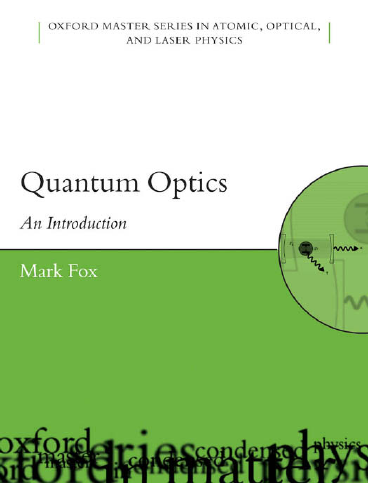
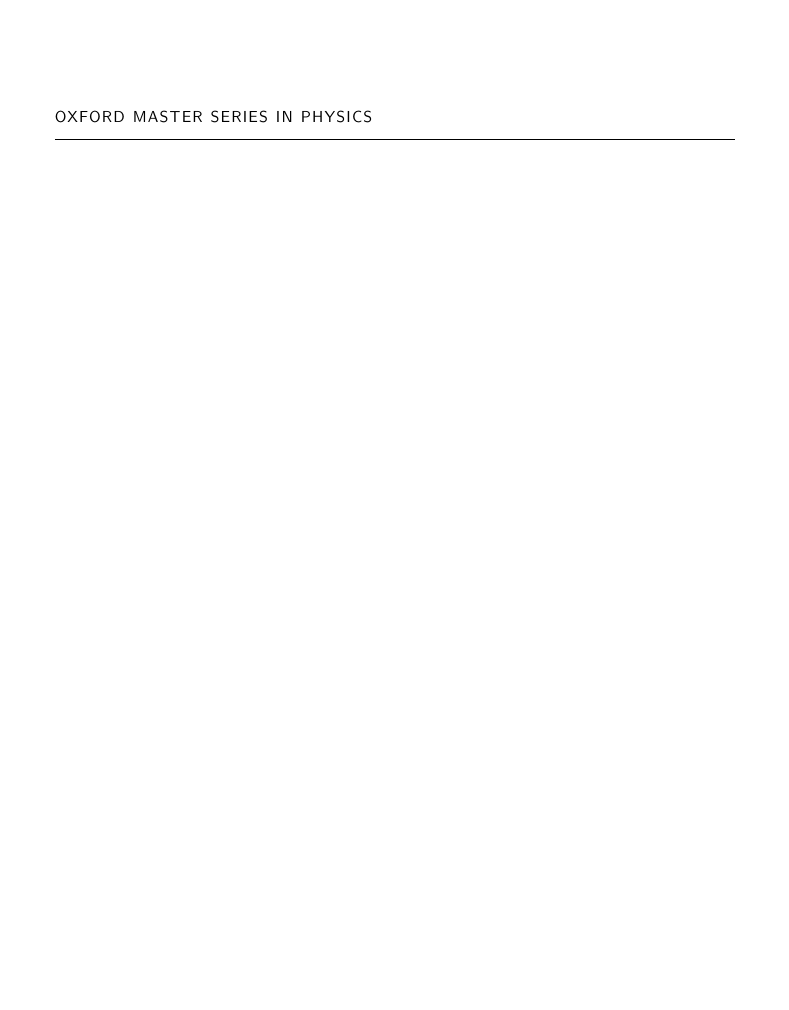
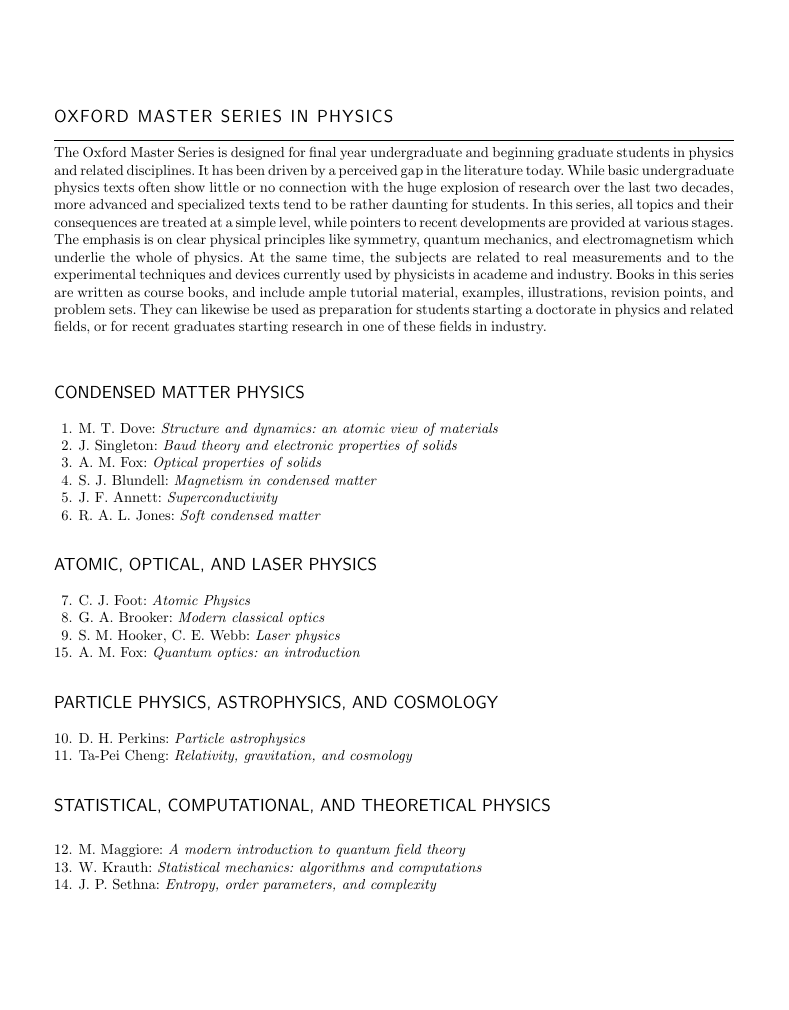


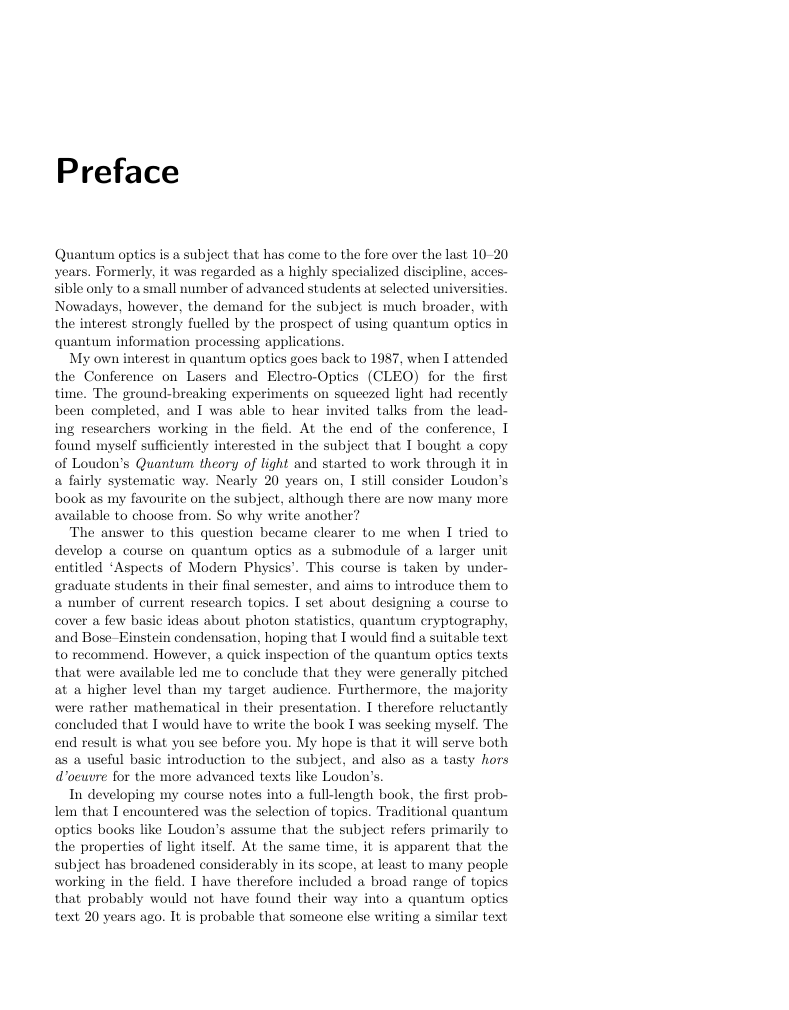

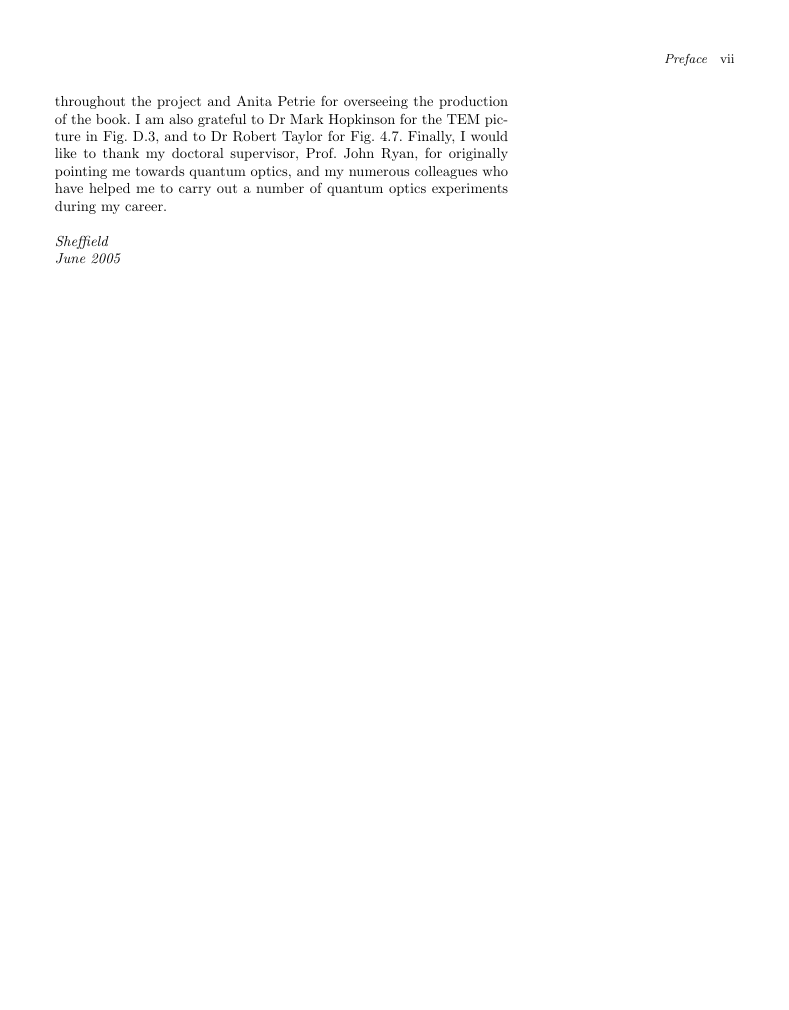








 2023年江西萍乡中考道德与法治真题及答案.doc
2023年江西萍乡中考道德与法治真题及答案.doc 2012年重庆南川中考生物真题及答案.doc
2012年重庆南川中考生物真题及答案.doc 2013年江西师范大学地理学综合及文艺理论基础考研真题.doc
2013年江西师范大学地理学综合及文艺理论基础考研真题.doc 2020年四川甘孜小升初语文真题及答案I卷.doc
2020年四川甘孜小升初语文真题及答案I卷.doc 2020年注册岩土工程师专业基础考试真题及答案.doc
2020年注册岩土工程师专业基础考试真题及答案.doc 2023-2024学年福建省厦门市九年级上学期数学月考试题及答案.doc
2023-2024学年福建省厦门市九年级上学期数学月考试题及答案.doc 2021-2022学年辽宁省沈阳市大东区九年级上学期语文期末试题及答案.doc
2021-2022学年辽宁省沈阳市大东区九年级上学期语文期末试题及答案.doc 2022-2023学年北京东城区初三第一学期物理期末试卷及答案.doc
2022-2023学年北京东城区初三第一学期物理期末试卷及答案.doc 2018上半年江西教师资格初中地理学科知识与教学能力真题及答案.doc
2018上半年江西教师资格初中地理学科知识与教学能力真题及答案.doc 2012年河北国家公务员申论考试真题及答案-省级.doc
2012年河北国家公务员申论考试真题及答案-省级.doc 2020-2021学年江苏省扬州市江都区邵樊片九年级上学期数学第一次质量检测试题及答案.doc
2020-2021学年江苏省扬州市江都区邵樊片九年级上学期数学第一次质量检测试题及答案.doc 2022下半年黑龙江教师资格证中学综合素质真题及答案.doc
2022下半年黑龙江教师资格证中学综合素质真题及答案.doc